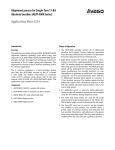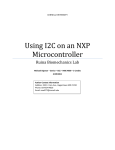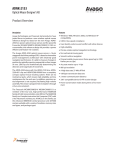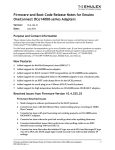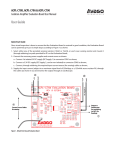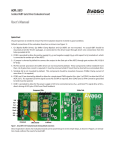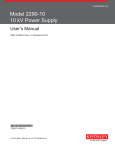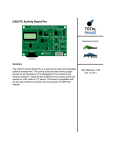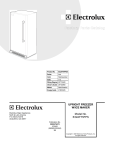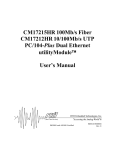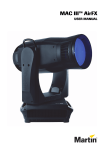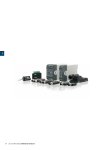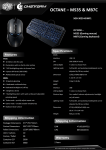Download User Manual
Transcript
HEDS-8949 & HEDS-8969 Alignment Kit for AEAT-9000 Encoders User Manual 1. Introduction Overview Features This user manual describes the Avago HEDS-8949 and HEDS-8969 alignment kit. The kit features real-time IC monitoring the IC output during user alignment. The alignment kit consists of the IC interface hardware and Windows software. The IC interface hardware is a microcontroller system that connects the HEDS-8949 / HEDS-8969 encoder to the PC through a USB cable. This user manual includes hardware setup, software setup and software operating illustrations. • Bus-powered USB device • Real-time monitoring of LocTest and TiltOut output • Real-time monitoring A/B Incremental signal pairs or Sine/Cosine signal pairs. • Real-time monitoring of SSI data. • Data capturing rate at 4000 samples per second Ordering Information HEDS-8949 for AEAT-9000-1GSH0 HEDS-8969 for AEAT-9000-1GSH1 and AEAT-9035 2. Hardware Components Unpacking the Unit Figure 1 illustrates the typical packing of the HEDS-8949/ HEDS-8969 alignment kit. The package includes:1. USB cable 2. Alignment module (HEDS-8949/8969) 3. Encoder cable (HEDS-8949/8969) (24/30 pin for HEDS-8949, AEAT-9000-1GSH0) or (24/16 pin for HEDS-8969, AEAT-9000-1GSH1/AEAT-9035) 4. Installation CD Figure 1. Inside the alignment kit box Figures 2 and 3 show the various components provided in the alignment kits. The USB cable (1) connects to the USB port of the alignment kit (2). 2 2 1 1 4 3 Figure 2. Alignment kit components for HEDS-8949 2 4 3 Figure 3. Alignment kit components for HEDS-8969 Figures 4 and 5 show the HEDS-8949/ HEDS-8969 alignment modules. Figure 4. Alignment module top cover for HEDS-8949 Figure 5. Alignment module top cover for HEDS-8969 Connect the alignment kit to your PC using the provided USB cable. When the alignment module is powered-up the red LED will illuminate. The green LED will blink when there is communication between the PC and encoder. The kit’s current consumption is less than 200 mA. The kit includes a 100 mA current limiting circuit for the encoder. If the current consumption for the alignment kit exceeds 100 mA, the programmer will cut off the supply to the encoder. On the left side of the programmer is the programming connector, which is a 24-pin (2 x 12) rectangular header. This connector is used to connect a cable harness to the encoder. Figure 6 shows the encoder cable and connectors. The programming connector pin names and function are described in Table 1 (shown on next page). Use for AEAT-9000-1GSH0 Encoder Connector (To Target System) Pin 1 Matching Connector 23 21 19 17 15 13 11 9 7 5 3 1 24 22 20 18 16 14 12 10 8 6 4 2 Figure 6. Encoder cable and connectors: 24-way cable for connecting the encoder IC of the target system 3 The encoder cables are shown below in figures 7a and 7b. Figure 7a. Encoder cable, HEDS-8969 (for AEAT-9000-1GSH1/AEAT-9035) Table 1. Programming connector pin descriptions PIN Name Function PIN 1 INCA Incremental A Input PIN 2 INCB Incremental B Input PIN 5 SCL+ SSI Shift Register Clock PIN 6 SPI_SI SPI Data Input PIN 7 SPI_CLK SPI Clock PIN 8 NSL+ SSI Enable PIN 9 LERR Error pin PIN 10 GND IC Ground PIN 11 Zero_RST Zero Reset Input PIN 12 DOUT SSI Data Output PIN 13 Vdd IC supply PIN 14 LocTest Alignment Locate Signal PIN 15 MSBINV Inverted Counting Input PIN 18 TiltOut Tilt Alignment Output PIN 19 DIN+ SSI Data Input PIN 20 SPI_SO SPI Data Output PIN 21 Cosine+ Cosine+ Input PIN 22 Sine+ Sine+ Input PIN 23 Cosine- Cosine- Input3 PIN 24 Sine- Sine- Input4 PIN 3 PIN 4 PIN 16 PIN 17 4 Figure 7b. Encoder cable, HEDS-8949 (for AEAT-9000-1GSH0) 3. Software Installation The user manual and the programmer application software are on the installation CD. To install the application software, browse the installation CD using Explorer and double-click the 'Avago AEAT-9000 Alignment Kit' icon. The installation will run automatically. Figures 8, 9 and 10 illustrate the software installation process. Figure 5: Software installation start up screen. Click Next to start installation. Figure 8. Software installation start up screen. Click Next to start installation. Figure 9. Installation folder selection screen. Specify the installation folder to change the default path. Click Next to continue. 5 The installation process will continue after the step shown in Figure 10, and finally, an “Installation Complete” screen will be shown. Figure 10. Click Next to confirm and start the installation. Locate the software by selecting Start > All Program > Avago AEAT-9000 Alignment Kit > AEAT-9000 Alignment Kit to run the software. To uninstall the software, open the Windows’ Control Panel, run the ”Add or Remove Program”, and locate ”Avago AEAT-9000 Alignment Kit”. Click “Change/Remove” and follow the screen instructions to remove the software. 6 4. Software Application 4.1 Device Monitoring To run the application software, click Start > All Program > Avago AEAT-9000 Alignment Kit > AEAT-9000 Alignment Kit. After selecting the software, the screen in Figure 11 will appear. The software has two tabs: Device Monitoring and Alignment. Device Monitoring provides real-time display of encoder data, and Alignment provides the interface for aligning the code disc. Figure 11 shows the main screen of the software. When the ”Connect” button is clicked, the software will locate and connect to the alignment kit. Once connected, real-time SSI angular data will be streamed to the software and displayed as raw 17-bit SSI data as well as the converted mechanical degree position. This is illustrated in Figure 12. Selection of Device Monitoring and Alignment Mode Figure 11. Optical encoder alignment main screen 7 Press this button to link the software to the Alignment Kit. Selection of signal pairs for signal plotting Virtual Oscilloscope Figure 12. Device monitoring tab The Zero Reset button allows the user to zero offset the encoder’s position data. When clicked, the alignment kit will be commanded to send a short HIGH pulse of 10 ms to the Zero_RST pin of the encoder. Check the ‘MSB Invert’ check box if inverted counting is required. When ‘MSB Invert’ is checked, the alignment kit will output a HIGH level on the “MSBINV” pin and vice versa. The software contains a virtual oscilloscope for plotting real-time data. For display, the user can select between two signal pairs: incremental A/B signal pairs and Sine/Cosine signal pairs. Signals are sampled at a 4000 Hz rate and transferred to the software via the USB bus. The software calculates the frequency of the signal, and derives the encoder disc rotation speed in RPM (Rotation per Minute). The timebase, volts per division and offset are set by the controls at the bottom of the screen shown in Figure 12. Four trigger modes are supported: None, Single, Normal and Stopped. The trigger source is fixed to the A signal for A/B incremental signal pairs and the sine signal for Sine/Cosine signal pairs. 8 4.2 Alignment Mode The alignment mode provides an interface for monitoring the LocTest and TiltOut signals for aligning the code disc. Figure 13 shows the alignment mode screen. The alignment mode measures and analyzes the LocTest and TiltOut signals and provides necessary alignment data to the user. The description of each alignment parameter is given in Table 2. Figure 13. Alignment mode 9 Table 2. Alignment data Vp-p MAX (LOCTEST) The maximum peak-to-peak voltage for the LOCTEST signal. The amplitude of the signal will depend on the total stack-up TIR of the code wheel. 2.80 V Nominal 2.70 2.60 2.50 2.40 Vp-p 2.30 2.20 2.10 2.00 1.90 0 Duty % AVG 45 90 135 180 225 270 315 360 Duty % is calculated on the TiltOut signal with the following formula: 0° 180° 360° V( ) SLO t T Duty % = t x 100% T The average value of Duty % is then calculated based on the number of valid TILTOUT pulses captured. ON Pulse Width The ON pulse width of the TiltOut signal, t. Pulse Ratio The ratio of periods between pulses generated at TiltOut. 0° 180° 360° V( ) SLO T1 T2 Pulse Ratio = T1 T2 Results 10 Provides a PASS / FAIL indicator based on the specification limit provided by the user. Software will analyze the alignment data and provide a PASS/FAIL indicator based on a set of specification limits provided by the user. To enter the specification limit setting menu, select Tools > Specification as shown in Figure 14. A specification settings dialog will then pop-up as shown in Figure 15. The purpose of each parameter is described in Table 3. Table 3. Specification settings Vp-p High Limit Vp-p Low Limit The maximum / minimum allowable peak-to-peak voltage for the LocTest signal. Duty % AVG Upper Limit Duty % AVG Lower Limit The maximum / minimum allowable PWM Duty % for the TiltOut signal. Please refer to Table 2 for the PWM Duty % calculation. Pulse Ratio High Pulse Ratio Low The maximum / minimum allowable pulse ratio for the TiltOut signal. The purpose of these parameters is to ensure the periods of the TiltOut pulses are consistent. Software will output a PASS indicator if all the specification limits in Table 2 are met. Please refer to the product datasheet for details on aligning the code disc. Select Tools > Specification to go into specification dialog Figure 14. Menu for the alignment specification Enable / Disable Specification Checking Figure 15. Specification dialog 11 5 Firmware Update This section describes the step-by-step procedures for updating the firmware of the HEDS-8949/8969 alignment box. 5.1 System Requirement The following items are required for updating the firmware of the alignment box • PC running Microsoft Windows XP operating system or later, and a free USB port • iBootloader Downloader PC software executable • Avago HEDS-8949/8969 firmware Hex file (*.hex) 5.2 Procedure Start the iBootloader Downloader software executable. The startup screen is shown in Figure 16. Connect the HEDS-8949/8969 alignment box to the PC using the USB port. When first connected, Windows will install the driver automatically. The downloader software will detect the alignment box and prompt if the connected device is connected in bootloader mode or application mode. Figure 16 shows the screen shot of downloader software when the alignment box is in application mode. Figure 16. Startup screen of the iBootloader downloader 12 Figure 17. Alignment box detected running in application mode To update the firmware, the user must switch the alignment box into bootloader mode by clicking the “Boot Mode” button shown in Figure 17. Once completed, the software will prompt a “Device attached” message and more button options are enabled, as shown in Figure 18. Figure 18. Alignment box detected and running in bootloader mode 13 Click the “Open Hex File” button and an open file dialog will be prompted. Locate and select the firmware Hex file as shown in Figure 19. Figure 19. Selecting the firmware Hex file Proceed with the firmware update by clicking the “Program/Verify” button as shown in Figure 20. Figure 20. Program verify process and upon completion of Hex file. 14 The firmware update will start and the progress status of the update will be shown in a message prompt. The firmware update process consists of an erase, program and verify cycle. Once completed, the downloader software will prompt an erase/program/verify completed successfully message as shown in Figure 21. Figure 21. Erase/Program/Verify process Finally, reset the alignment box by pressing the "Reset Device" button as shown in Figure 22. The alignment module will be running the updated firmware. Figure 22. Reset Device process. For product information and a complete list of distributors, please go to our web site: www.avagotech.com Avago, Avago Technologies, and the A logo are trademarks of Avago Technologies in the United States and other countries. Data subject to change. Copyright © 2005-2013 Avago Technologies. All rights reserved. AV02-3143EN - September 24, 2013















